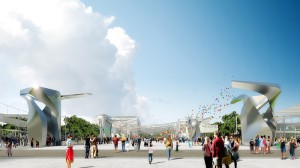The idea for The Wings was sparked by Daniel Libeskind’s desire to create a connection between the 2015 Milan Expo’s theme – ‘Feeding the Planet, Energy for Life’ – and its location in Milan, Italy. Given the Expo master plan, with its egalitarian organization around two axes – the Cardo and the Decumanus (major and minor), the plan was to create a kind of introduction to the Expo, using physical and conceptual portals into the site. The Expo offered to locate the sculptures at the center of the Expo site, the intersection of the axes – also known as Piazza Italia. Thus the sculptures transformed formally from gate-like structures to be approached from the front and passed through to free-standing sculptures experienced in the round. Placed at the four corners of the piazza, the dynamic figures of The Wings now defined and embraced the main public space of the Expo 2015. At ten meters tall, spanning ten meters across, these grand statues would stand as the guardians of the piazza – angels’ wings. 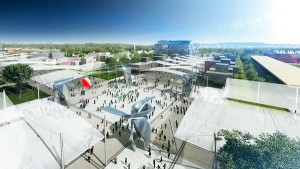
Like the global theme of the Expo, these sculptures – presented at the occasion of the Expo for the first time – will have a life far beyond the timeframe of the event in Milan. Therefore, aside from their form and position, it will also be possible for them to serve as communication devices – messengers. With this in mind, in collaboration with world technology leaders Siemens, light and sound installations have been integrated into each of the four structures. Two of them are animated visually and two with sound.
For the visual animations, the team interviewed many renowned creative media companies and chose to work with the London-based company innovision, whose approach was judged the most sympathetic and complementary to the project. innovision proposed to integrate LEDs with the sculptures’ surface and animate them with rhythmic patterns relating to the various themes of the Expo. These animations were to be thematically relevant but visually abstract and non-representational. This approach would steer the project away from becoming commercial. It was important that the animations did not render the sculptures mere billboards, but rather that they remained artistically suggestive. The more abstract approach also allows for multiple interpretations. The animations provoke thought rather than attempting to draw conclusions on very complex world issues. The two visually animated sculptures are imbedded with 10,000 LEDs from Traxon, a Siemens-related company at the forefront of LED technology. 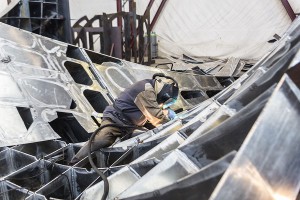
The sound installations take a similar approach to the visual ones. The two sonically animated structures have ten thousand perforations for sound waves to travel through and across. Daniel Libeskind chose to compose the soundtrack himself in collaboration with the composer Caleb Townsend. They are rhythmically structured and unpredictably nuanced.
Together, the sculptures are designed to embrace and celebrate the Expo, the site and visitors alike. The dynamic form will symbolize strength, resilience and optimism in the face of challenging world issues.
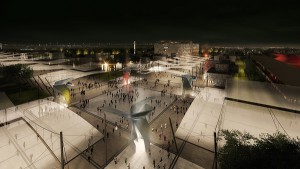 The wings – A perfect example
The wings – A perfect example
Sustainability: choosing the materials and ensuring they are produced and processed using environmentally friendly technologies, such as renewable energy and highly energy efficient machinery.
Feasibility: exploring the limits of your visions and ensuring that it can be done. The Wings carefully balance the physical dimensions of the artwork, the properties of the material, the aesthetic requirements, and many more elements.
Interactivity: defining new ways for communication. Technologies become part of the artwork, enhancing the experience from static sculpture to a dynamic and interactive communication.
Siemens technology flow is shaping current and future trends across the main themes of Digitalization, further cascaded into fundamental topics such as Future of Manufacturing, Sustainable Energy and Intelligent Infrastructure.
The Future of Manufacturing is one of the best examples of this increasing seamless connection between the virtual and the real worlds of product development and production. Manufacturing is becoming more and more digitalized, reflecting the need for more customized requests, and Siemens’ software-based innovations are helping to lay the foundations for the next industrial revolution.
Everything starts from data. Data feeds industries and countries and has a strong impact on successful development, focusing on effective and efficient management. That is where the Siemens competence comes in, drawing on unique know- how to combine effective and efficient management with engineering technology. This means pioneering hardware, software and data, giving customers the best information to make smart decisions. Proven outcomes of existing software solutions show how crucially they impact on the entire lifecycle of a product, increasing productivity in manufacturing and bringing a 50 percent reduction in time-to-market.
The Wings constitute an example of Siemens’ countless contributions to our daily lives. The creation of The Wings combine sophisticated technical processes with human skills and talents. Without these technologies, the construction of The Wings would not have been possible, but, to the same extent, human creativity and skills allowed this unique artwork to become a reality. It is thanks to the skills of a highly qualified workforce, capable of handling a forty-ton press and applying the correct level of pressure at the right places, that huge aluminium sheets were cut to size with minute precision, despite the complexity of their shape, to form what has undoubtedly become works of art. 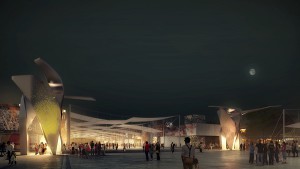
Construction making the sculptures
Before production, a unique DWG file for every piece of the sculpture – the skin plates and the inner construction – was created. When the material was in stock, the production of the sculptures started. Each piece was cut out of aluminum plates of approximately 8 by 2 meters in size. Each piece was marked with a unique number for traceability.
Flat parts were divided from the parts to be 3D-formed. All four sculptures were produced in the factory at the same time. With this process, a lot of material and time were saved. Where appropriate, during cutting, parts had their edges prepared for welding. The 3D forming was done by skilled people who had learned their craft over many years with steel and aluminum plates used in shipbuilding. Using large presses, almost any form could be made and, with their experience, the craftsmen and craftswomen knew exactly how to create the required forms.
All skin plates were marked with lines for wooden templates and with numbers corresponding with the inner construction. After the forming, the wooden templates were used for a final check.
Prefabrication
The skin plates and inner construction were built together in a factory.
Counter templates made of steel insured that the skin plates held their shape during this process. These templates were created in a 3D-drawing program and built using 3D measurement tools.
By arranging the skin plates in place, welders could start joining them together and then joining them with the inner construction. The welding was done for two sculptures at a time.
Assembly drawings and a 3D program were used to insure that the sculptures were made according to the 3D model.
[su_slider source=”media: 5053,5052,5051,5050″ title=”no”]

